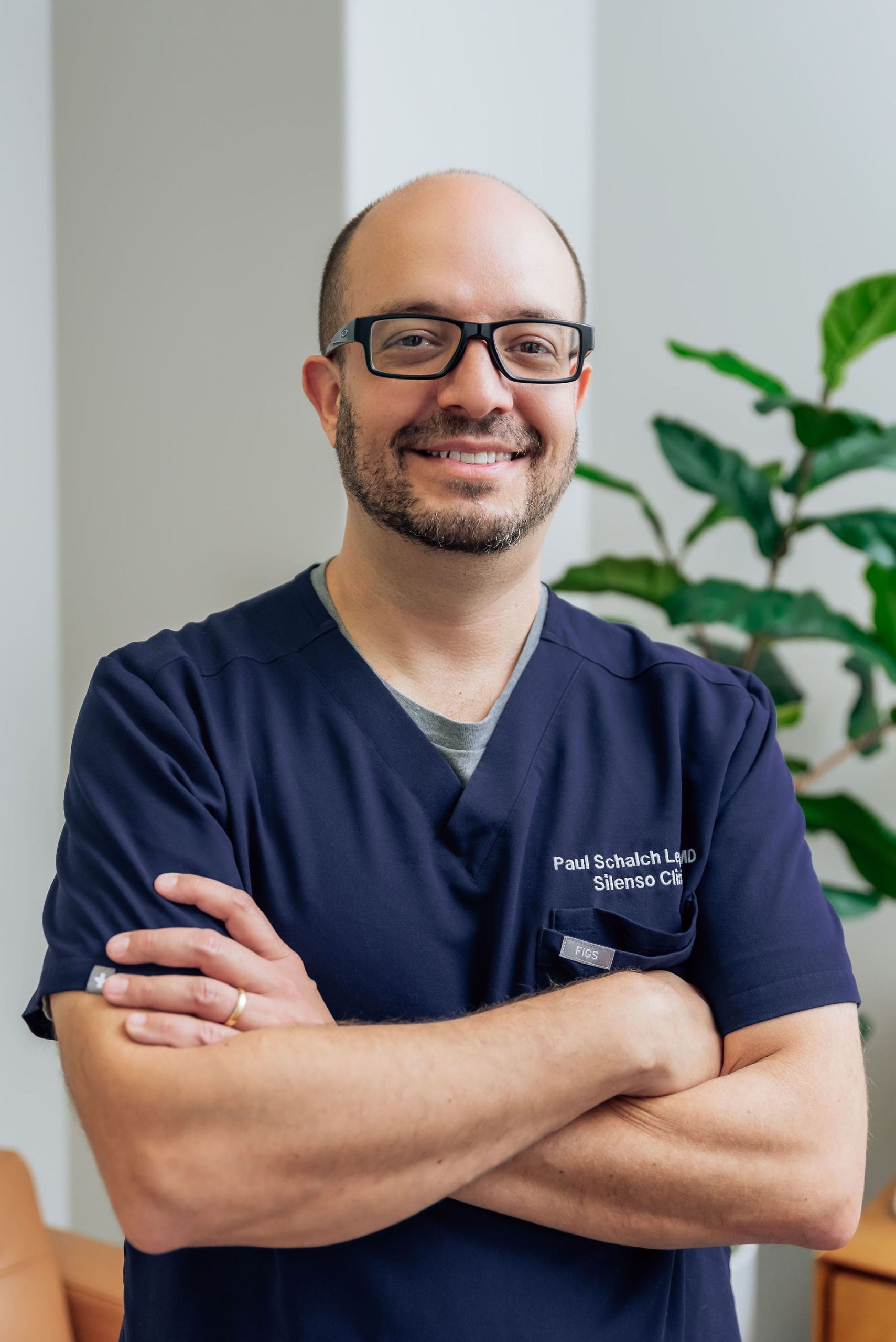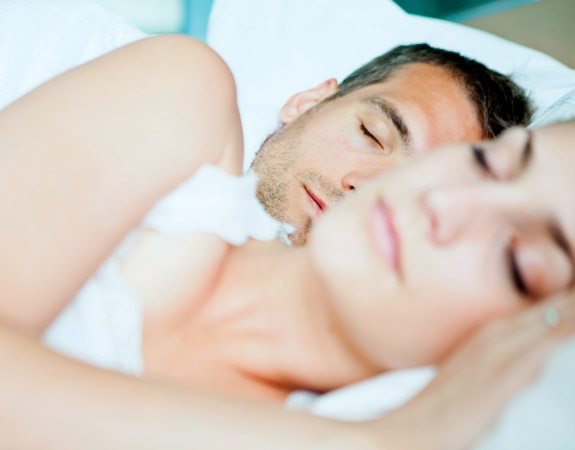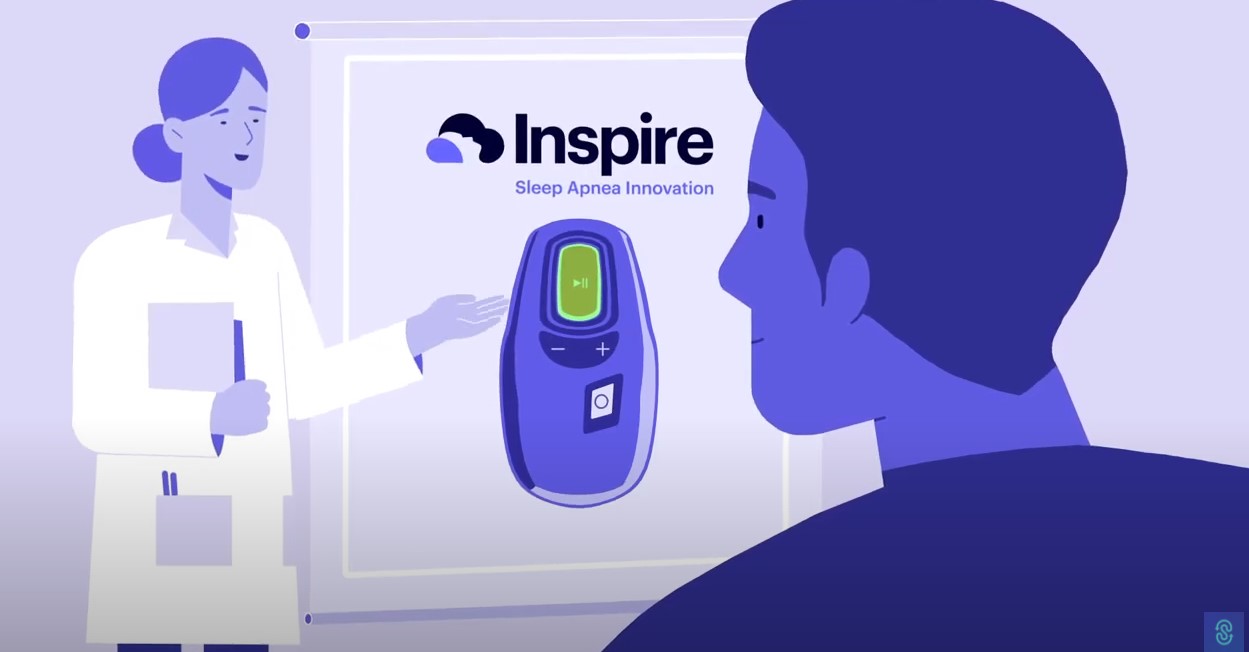Inspire for Sleep Apnea in San Diego | Silenso Clinic
This notorious cessation in breathing while sleeping is caused by a blocked airway or collapse of the pharynx (the cavity joining the nose and mouth to the esophagus).
While several treatments are available to patients with sleep apnea, such as continuous positive airway pressure (CPAP) or oral appliance therapy, some patients get the maximum benefit from Inspire therapy. Below, Silenso Clinic’s Dr. Paul Schalch Lepe, a board-certified otolaryngologist and sleep medicine specialist affiliated with UC San Diego, explains everything you need to know about Inspire therapy for sleep apnea.
If you’re experiencing sleep apnea and aren’t compatible with CPAP or other forms of treatment, then reach out to Dr. Schalch Lepe at (858) 925-5800 or fill in his contact form to arrange your consultation for Inspire for sleep apnea in San Diego today. Silenso Clinic is located in Carmel Valley in North San Diego County and serves many communities throughout the greater San Diego area, including La Jolla, Carlsbad, Encinitas, Del Mar, Coronado, Eastlake, Chula Vista, and more.

Specializing in the treatment of a variety of conditions (deviated septum, nasal obstruction, snoring, obstructive sleep apnea, etc.), Dr. Schalch Lepe is highly qualified and motivated to provide his patients with the best possible treatment results. Dr. Schalch Lepe takes an in-depth, personalized approach with each patient to ensure they receive the best possible treatment for their situation.
Originally from Mexico City, Mexico, Dr. Schalch Lepe has the unique perspective of having trained in multiple countries. This experience has led him to be sought out by domestic and international patients, many of whom are Mexican ex-pats living throughout San Diego County and Southern California.
What is Inspire for Sleep Apnea?
Inspire therapy for sleep apnea is an FDA-approved procedure that treats sleep apnea with the implantation of a device into the patient’s body.
Many patients find that CPAP therapy disturbs their sleep, and they cannot get a decent night’s rest while wearing the CPAP mechanism. In these cases, Inspire therapy may a favorable alternative.
Without a mask, hose, or external device whatsoever, Inspire sleep apnea therapy treats the root cause of obstructive sleep apnea.
How Does Inspire for Sleep Apnea Work?
Inspire treatment for sleep apnea begins with a comprehensive evaluation, including a procedure called Drug Induced Sleep Endoscopy (DISE), that involves examining the upper airway while under general anesthesia, and it is aimed at establishing the areas of obstruction in the upper airway and determining candidacy for the Inspire procedure.

In candidates that are appropriate and decide to proceed with Inspire, the surgical procedure will involve inserting the Inspire device just under your clavicle, similar to a cardiac pacemaker.
The device is composed of three elements: the generator, the breathing sensor lead, and the stimulation lead.
While you sleep, the breathing sensor lead monitors your breath rate. If there is a cessation in your breathing, the generator sends a pulse of energy through the stimulation lead, which is attached to the hypoglossal nerve. The hypoglossal nerve is responsible for moving the tongue and other muscles of the airway.
When the stimulation lead of the Inspire device triggers the hypoglossal nerve, your airway is held open by your own tongue and throat muscles, which prevents it from collapsing and causing obstruction.
The device is turned on and off with a small remote controller – patients turn the Inspire device on as they go to bed and turn it off when they wake up. The device doesn’t require any changes in behavior other than turning the device on and off, which is one reason it is such a popular treatment for sleep apnea.
Patient Testimonial
What are the Benefits of Inspire for Sleep Apnea?
As we’ve mentioned, the primary treatment for sleep apnea is continuous positive airway pressure therapy (CPAP).
This is a highly effective treatment that uses a machine attached to a hose and a face mask which the patient wears during sleep. The device sends air through the mask to the patient, which continuously keeps the airways open to prevent sleep apnea.
The problem with CPAP therapy is many patients find the treatment invasive and disturbing to their (or their partner’s) sleep. Furthermore, patients who rely on CPAP treatment need to take the machine with them on overnight trips.
Inspire for sleep apnea solves all of these problems because the device is implanted into the patient. Patients only need to take the small remote controller with them when going on holiday or sleeping away from home, so it is far more convenient than CPAP treatment.

Watch: Inspire information
Better Breathing Starts Today!
Dr. Paul Schalch Lepe is a renowned breathing and sleep surgeon. His greatest pride is giving his patients the ability to breathe, sleep, and feel their best using the latest, innovative surgical and non-surgical procedures.
What Can I Expect Before, During, and After My Inspire Sleep Apnea Treatment?
If you experience sleep apnea in any form, particularly obstructive sleep apnea (OSA), then a consultation with a sleep and snoring specialist is your first step towards ensuring you enjoy a safe, healthy, and uneventful sleep every night.
In your initial consultation, Dr. Schalch Lepe will assess your overall health and sleep apnea history to determine your suitability for the Inspire sleep apnea therapy.
In most instances, suitable candidates are those who:
- Have a diagnosis of moderate to severe obstructive sleep apnea with an apnea-hypopnea index (AHI) ranging between 20-65, with no significant central or mixed apneas
- Find CPAP treatment unsuitable or too disruptive, and are unable to tolerate it
- Are close to a healthy body weight , with a body mass index below 35
- Are adults, 18 years of age or older
Leading up to your Inspire treatment, it is strongly suggested that patients take a comprehensive assessment of their nutrition and lifestyle and optimize any aspect for achieving and maintaining healthy body weight. Obesity can cause and worsen OSA, and weight loss will improve short and long term outcomes of any treatment strategy..
Once Dr. Schalch Lepe determines that Inspire is the correct procedure for you, then you will need to apply for insurance coverage (most insurers cover Inspire, including Medicare). Approval can take anywhere between several days to several weeks, and our preauthorization team will work on securing coverage prior to proceeding with surgery.
The Inspire system is generally inserted in an outpatient procedure, with the vast majority of patients returning home that same day.
The procedure typically takes around 2hours for the system to be fitted properly. Dr Schalch Lepe performs the latest FDA-approved two-incision approach, which decreases operative time as well as postoperative pain, and allows for faster healing and recovery.
After surgery, patients return home to begin recovery.
Most patients experience mild to moderate pain where Dr. Schalch Lepe inserts the device and can take over-the-counter pain medication to address this pain. While full recovery takes around 2weeks, patients generally resume less strenuous activities within a couple of days.
We strongly recommend waiting at least a few weeks before considering more strenuous exercise and activities.
Approximately 4 weeks after the procedure, the patient is referred to the sleep center, where the device is first activated, and then subsequently adjusted and customized. Our clinic partners with several top-notch sleep labs and practices that have expertise in the activation and management of the Inspire device.
Why Choose Dr. Schalch Lepe as My Sleep Apnea Specialist in San Diego?
Sleep and breathing surgeonDr. Paul Schalch Lepe specializes in a variety of conditions (deviated septum, sinus pressure, allergies, enlarged inferior turbinates, obstructive sleep apnea, snoring, etc.) all meant to help his patients achieve improved quality of life by breathing better and sleeping easier. Dr. Schalch Lepe takes an in-depth, personalized approach with each patient to ensure they receive the best possible treatment for their situation.
Originally from Mexico City, Mexico, Dr. Schalch Lepe has been fortunate to gain unique perspectives and experience from his international training. This experience has led him to be sought out by domestic and international patients, many of whom are Mexican ex-pats living throughout San Diego County and Southern California.
Watch: Paul Schalch Lepe MD, FACS discusses Inspire technology
Inspire for Sleep Apnea in San Diego, CA
If you’ve been diagnosed with moderate to severe obstructive sleep apnea and find that CPAP therapy doesn’t work for you, then Inspire therapy can turn your life around.
Suffering from sleep apnea can be life-threatening, but even in less severe cases, sleep apnea will ruin your and your partner’s sleep, which impacts your life. To remedy this, reach out to Dr. Schalch Lepe. Contact 858-925-5800 or fill out his online form to begin your journey towards a better life today.
Sleep Apnea FAQs
Sleep quality is essential to a properly functioning mind and body, but patients suffering from sleep apnea may very well not be getting the deep sleep they need.
With sleep apnea, a patient stops breathing for short periods. These momentary pauses in breath trigger a reflex in the body to startle the sleeper awake, just enough for them to take a breath. Sleep apnea patients don’t regain full consciousness during these brief arousals, so you won’t recall them. However, the sleep cycle still gets interrupted several times each night, leading to chronic fatigue, low energy, poor concentration, irritability, and many other health concerns. Here, Dr. Schalch Lepe discusses the different stages of sleep and how sleep apnea prevents patients from getting the full sleep cycle they need.
Deep sleep is essential for the brain and body. During deep sleep, we:
- Consolidate new memories
- Regenerate brain and body tissue
- Secrete growth hormones
- Process stimuli and sensory input from the day for a fresh slate the next morning
When anything interferes with our sleep, we might not reach deep enough sleep for these functions to occur.
Sleep is cyclical, meaning it has sequential stages the body and brain go through. The presence or absence of rapid eye movement differentiates the four stages of sleep. A healthy adult repeats the sleep cycle three to four times per night.
Each stage of sleep brings different characteristics, with the body falling progressively deeper into sleep as the night progresses.
- Stage N1: This stage starts right after you fall asleep and usually lasts for only 10 minutes.
- Stage N2: The muscles relax, and slow-wave brain activity known as delta waves may begin. This stage typically lasts 30 to 60 minutes.
- Stage N3: Here, in “deep sleep,” delta waves increase. Your body may move, though it will be challenging to awaken. This stage lasts for 20 to 40 minutes.
- REM: This stage is when you dream. The eyes start to flutter, breathing becomes irregular, and the muscles become immobilized.
Adequate REM sleep is crucial for optimal brain functioning. Researchers believe the REM stage is critical for learning and memory consolidation, while helping restore your brain’s natural chemical balance.
If you suspect you suffer from sleep apnea or a partner tells you so, we recommend contacting Dr. Schalch Lepe for a diagnostic sleep test. He will analyze your breathing during your sleep and assign you an apnea-hypopnea index score according to the severity of your sleep apnea.
Those suffering from obstructive sleep apnea or sleep apnea experience short apnea or hypopnea episodes during their sleep.
An apnea episode is a total breathing stoppage that lasts more than 10 seconds, despite persistent respiratory effort.
A hypopnea episode is when you are still breathing, but your airflow becomes constricted enough to cause a decrease in your blood oxygen level.
A doctor can calculate your apnea-hypopnea index score by dividing the total number of apnea and hypopnea episodes by your total sleep time. This score is a crucial number to remember, as it is a primary measure for detecting sleep apnea’s presence and severity.
Your AHI score is beneficial in determining sleep apnea severity. These scores are as follows.
- None/minimal: AHI less than 5
- Mild: AHI between 5 and 15
- Moderate: AHI between 15 and 30
- Severe: AHI greater than 30
Dr. Schalch Lepe will likely also administer a comprehensive sleep study to identify in-depth information on your sleep habits and determine the best treatment method, but this AHI score is useful during preliminary diagnostics and helping you understand your condition.
Once a doctor has diagnosed you with sleep apnea, you can try several at-home remedies to try and improve it. The sooner you start working on treating your sleep apnea, the quicker your risk for health conditions such as cardiovascular disease will revert to baseline.
You can familiarize yourself with a wide range of sleep apnea treatments, including the following.
- Lifestyle changes, such as weight loss
- Continuous positive airway pressure therapy
- Mandibular advancement devices
- Hypoglossal nerve stimulators
- Upper airway surgery
